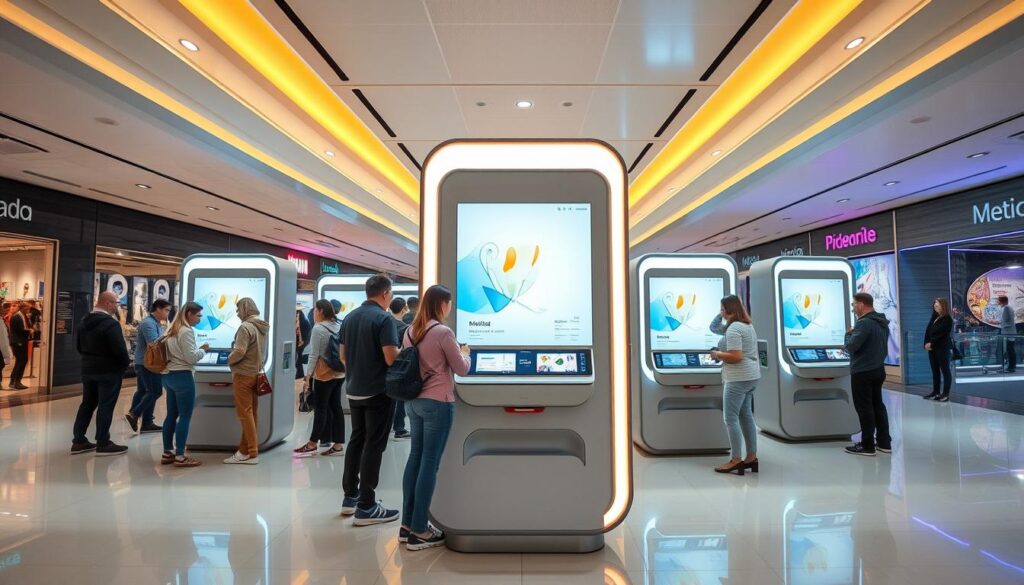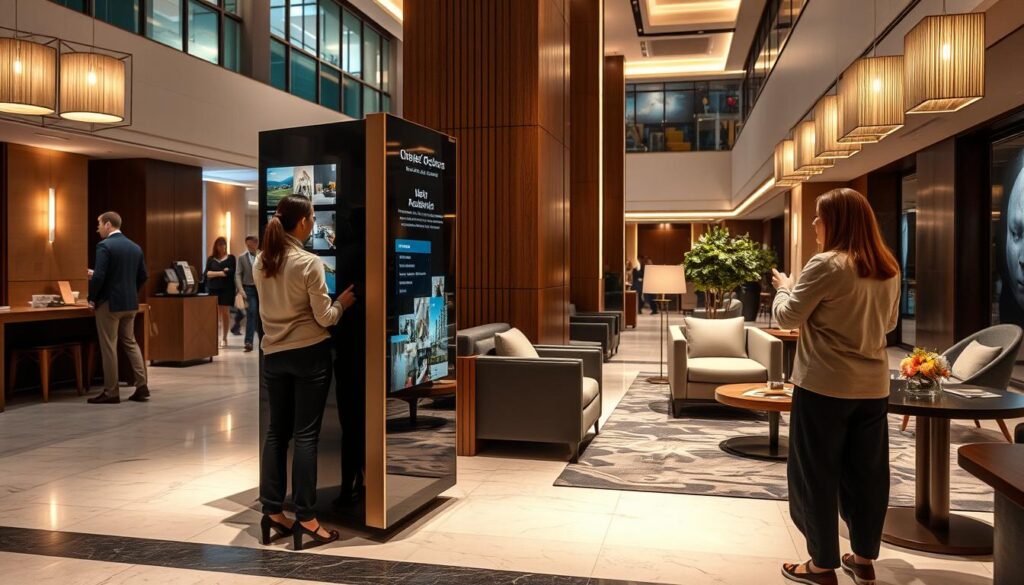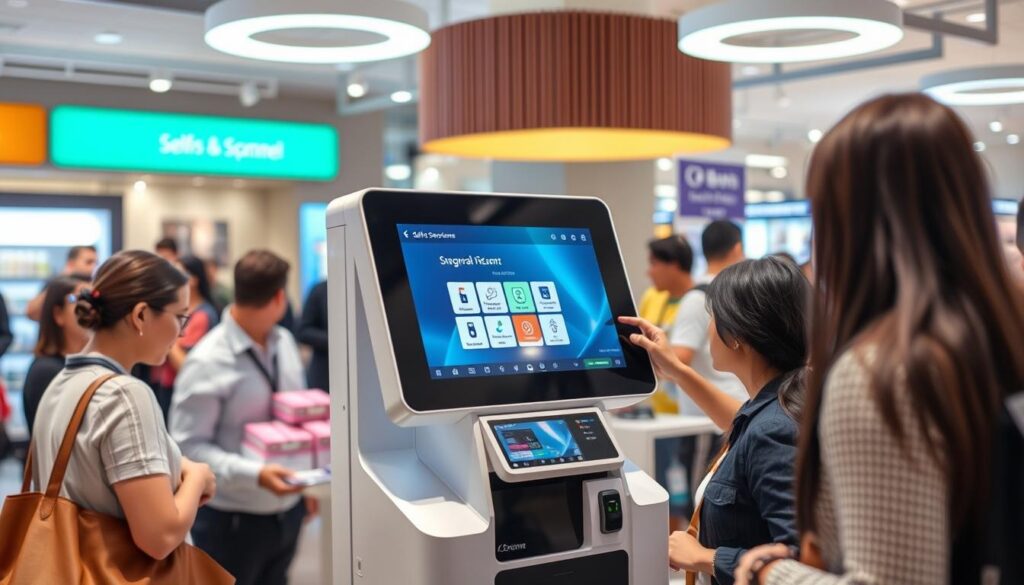Self-service kiosks are becoming more common in places like restaurants, airports, and grocery stores. They offer convenience, efficiency, and help with social distancing. These kiosks are changing how we interact with businesses, making things faster and more satisfying for customers.
In the quick-service restaurant world, these kiosks can boost profits by up to 30%. They’re not just for food places, though. Malls, airports, universities, and stadiums use them to help visitors find their way and pay bills. Tablet-based kiosks have made these solutions more affordable for businesses.

Recent global events have made people want more self-service options, with 81% of customers asking for it. Companies like Walmart, Apple, and Hilton are already seeing the benefits. They’ve noticed better employee productivity and happier customers.
Key Takeaways
- Self-service kiosks can increase profits by up to 30% compared to traditional cashier transactions.
- 81% of customers want more self-service options, driving the adoption of digital self-service terminals.
- Interactive kiosk solutions can enhance customer experience, reducing wait times and improving overall satisfaction.
- Self-service kiosks are being used in various industries, including restaurants, airports, and grocery stores.
- Digital self-service terminals can provide a self-service kiosks example for businesses to enhance efficiency and reduce costs.
- The use of self-service kiosks can improve employee productivity and customer satisfaction, as seen in companies such as Fabletics and Walmart.
Understanding Modern Self-Service Kiosks Example Applications
Self-service kiosks are now key in many industries, changing how businesses work and talk to customers. The self-serve kiosk design has grown to meet different needs. It offers benefits like better customer service, lower labor costs, and more efficient operations. A big plus is making processes smoother, leading to happier customers and more work done.
In retail, healthcare, and banking, self-service kiosks play a big role. Retail stores use them for finding products and checking out. Healthcare places use them for checking in and managing lines. Thanks to kiosk technology innovations, businesses can offer more personalized experiences, using data to keep customers coming back.
Some main uses of self-service kiosks are:
- Retail self-service solutions for ordering and checkout
- Healthcare check-in systems for patient registration and queue management
- Banking ATM innovations for various financial services
The use of self-service kiosks is set to rise, with the kiosk market expected to grow 7.1% yearly from 2022 to 2030. As companies keep investing in kiosk technology innovations, we’ll see more improvements in self-serve kiosk design and self-service kiosk benefits. This will make the customer experience even better.
Revolutionary Interactive Kiosk Solutions in Hospitality
The hospitality industry has seen big changes with interactive kiosk solutions. Hotels use technology to make guest experiences better, work more efficiently, and offer custom services. A user-friendly kiosk interface is key, making it easy for guests to use and get what they need.
Hilton’s mobile app lets guests manage their stay, from picking rooms to getting digital keys. This self-service kiosk implementation boosts guest happiness and cuts down on hotel staff’s work. The Cosmopolitan Hotel in Las Vegas has a digital concierge named Rose. It shows how AI and chatbots can help touchscreen kiosk systems offer help any time of day.
Interactive kiosk solutions in hospitality bring many benefits:
- Enhanced guest experience
- Streamlined operations
- Personalized services
- Reduced wait times
- Increased operational efficiency

The hospitality industry is always changing, and interactive kiosk solutions are becoming more popular. With user-friendly kiosk interface and self-service kiosk implementation, hotels can make guests happier, save money, and work better. Touchscreen kiosk systems will help hotels offer more personal services and improve the guest experience.
| Hotel | Kiosk Solution | Benefits |
|---|---|---|
| Hilton | Mobile app | Improved guest satisfaction, reduced workload |
| Cosmopolitan Hotel | Digital concierge (Rose) | 24/7 guest assistance, personalized services |
Essential Features of Successful Digital Self-Service Terminals
When making modern kiosk apps, it’s important to think about what makes them good for users. A kiosk that’s easy to use helps speed up processes and cuts down wait times. Key features include thermal printers, card readers, and simple touchscreen interfaces.
Some key features of digital self-service terminals are:
- Intuitive navigation and clear visual cues
- Thermal printers and card readers for expanded functionality
- Security measures to protect user data and prevent unauthorized access
- Accessibility considerations, including ADA compliance, to ensure usability by all customers
By adding these features, businesses can make kiosks that save on labor and make customers happier. A well-designed kiosk interface is key to these benefits and a good user experience.
The main goal of digital self-service terminals is to offer quick, easy, and personalized service. By focusing on user experience and adding important features, businesses can make successful kiosk apps. These apps help engage and keep customers coming back.
| Feature | Benefit |
|---|---|
| Intuitive Navigation | Reduced wait times and improved user experience |
| Thermal Printers and Card Readers | Expanded functionality and convenience |
| Security Measures | Protected user data and prevented unauthorized access |
| Accessibility Considerations | Ensured usability by all customers, including those with disabilities |
Implementing Touchscreen Kiosk Systems: Best Practices
When setting up self-service kiosk implementation, planning is key. You need to set clear goals, design easy-to-use interfaces, and pick the right vendors. The aim is to make touchscreen kiosk systems efficient and better for customers.
Prototyping and pilot testing are vital in kiosk technology innovations. They help spot and fix problems before you roll out the kiosks. Also, think about the cost, how well it works with your systems, and if it can grow with your business. The cost of self-service kiosk implementation can vary a lot, depending on your needs.
Touchscreen kiosk systems bring many benefits. They make customers happier, work more efficiently, and help gather useful data. For instance, people often spend more when they order at kiosks than at cashiers. Plus, kiosk technology innovations help businesses get real customer data, like what they like and how they behave.

To make self-service kiosk implementation a success, focus on making the interface easy to use. Give clear instructions and support to customers. By doing this, companies can use touchscreen kiosk systems and kiosk technology innovations to grow and please their customers.
Conclusion: The Future of Self-Service Kiosk Technology
The need for self-service options is growing fast. Over 67% of customers now prefer these easy solutions. This trend is making self-service kiosks example more popular than ever. They are changing many industries, like retail, healthcare, banking, and hospitality.
These kiosks are making things more efficient and saving money. They also make customers happier. This is because they offer better service and easier ways to do things.
New tech like artificial intelligence and augmented reality is coming to self-service kiosks. This will make their services even better. Soon, we’ll see more personalized and smart interactions. This will help more businesses use these helpful tools.
Self-service kiosks are getting better at keeping things safe and easy for everyone. They are also becoming more eco-friendly. This means they will keep changing how we shop and interact with businesses. Soon, we’ll see even more ways to make things easy and fun for everyone.
FAQ
What are self-service kiosks and how are they transforming customer experiences?
Self-service kiosks are digital terminals that let customers do things on their own. They can check in, buy products, or get info. These kiosks are changing how we shop, bank, and get medical care. They make things faster and let customers control their own experience.
What are some key applications of self-service kiosks in different industries?
In retail, kiosks help with self-checkout and show product info. In healthcare, they speed up patient check-in. Banking ATMs now offer more services than just cash withdrawals.
How are hotels and the hospitality industry leveraging interactive kiosk solutions?
Hotels are leading in using self-service kiosks. They improve guest service and make things more efficient. For example, Hilton lets guests choose rooms and get keys digitally. The Cosmopolitan Hotel has a digital concierge, Rose, for 24/7 help.
What are the key components that contribute to the success of digital self-service terminals?
Digital self-service terminals need a few things to work well. They need an easy-to-use interface, the right hardware, and strong security. They also need to be accessible to everyone.
What are the best practices for implementing touchscreen kiosk systems?
To set up touchscreen kiosks right, start with a good plan. Then, build a prototype, test it, and roll it out fully. Choose the best vendors and think about cost, compatibility, and growth. Also, train staff and help customers get used to it.